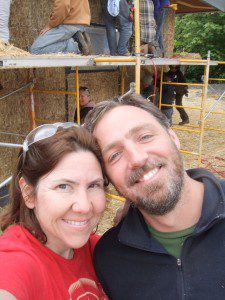 This awesome article from Sutherland Living Magazine is the creation of a recent straw bale workshop participant, Tiffany Redding. Her enthusiasm and genuine excitement to learn were contagious during that workshop and she will long be remembered by all of those there. Tiffany’s article, “Home Sweet Home, is reprinted courtesy of Sutherland Living Magazine – extraordinary living for ordinary people
This awesome article from Sutherland Living Magazine is the creation of a recent straw bale workshop participant, Tiffany Redding. Her enthusiasm and genuine excitement to learn were contagious during that workshop and she will long be remembered by all of those there. Tiffany’s article, “Home Sweet Home, is reprinted courtesy of Sutherland Living Magazine – extraordinary living for ordinary people
Home Sweet Home
Straw Bale is an old building material with new relevance
On the treeless Nebraskan plains of the 1800s, resourceful settlers were faced with a shortage of building materials and a dire need to provide shelter for animals and people alike. So they turned to a technique of their European forbears that makes use of an inexpensive and readily available natural material: bales of straw. The bales were stacked, coated with natural plaster, and roofed – and some of them survive to this day, providing robust protection from the harsh Midwestern weather. This simple system is experiencing a surge of popularity in the new millennium. Advocates of straw bale construction include people on a limited budget, fans of DIY who appreciate handcrafted work, and those interested in protecting the environment and living in a more sustainable way.
All three of those descriptions applied to me, and the allure of learning to build my own straw bale home became too strong to resist. I joined a group of thirty strangers for a weeklong hands-on workshop on the beautiful Oregon property of our hosts Ken and Sarah Edwardsson. The clinic was led by Andrew Morrison of StrawBale Innovations, LLC. I had been perusing his StrawBale.com website for some time, and it was chock full of testimonials and inspirational stories from all facets of the green building world.
Andrew’s email signature reads “Consultant, Teacher, Inspiring Change”. In my work as an architect for cutting-edge green projects, I see a lot of similar claims – a greener-than-thou marketing strategy is all the rage these days – so I had no particular expectations, figuring simply that Andrew would teach us how to build something. This he did, in spades (builder’s pun intended). But in the end we learned very much more than that.
Day 1

Andrew fills us in on his background: educated as a glacial geologist, he’s undertaken a lot of grueling field work; later his studies turned to residential design and construction, and he eventually found a niche for his passion: straw bale design and construction.
Notebooks and pens are busy for the next couple of hours as the basic principles of straw bale construction are described: lots of questions, lots of sketching. When we have sat so long that the camp chairs are frozen to our backsides, the lecture ends and we eagerly jump up, ready to stack some bales. Not so fast – remember the old adage, “proper preparation prevents poor performance”? There is a great deal of setup and protection to do, plenty to keep us all busy.
Ken and Sarah’s contractor friend has constructed a beautiful heavy timber frame which is to remain exposed on the inside of their building, and this needs to be wrapped in plastic and taped off so that no plaster or dirt will ruin its surface. Surprising how long it takes to fully mask off a frame like that; then again, anyone who’s ever painted their bathroom knows that the taping and prep work is pretty painstaking. We spend the afternoon trying to remember each other’s names and politely asking for this tool or that, but by dinnertime the work and the friendliness have started to jell.
For more than a century, small buildings in the United States have usually been “stick-built”: that is, walls are made of many slender studs of wood or metal, spaced an arms-length apart and nailed or screwed together to form a framework. Siding of wood, plaster, stone or metal is then fastened to the outside to keep weather and critters out; some kind of plane, typically drywall, is fastened to the inside to provide a place to hang your family photos. This kind of assembly provides very little thermal insulation, so the shallow cavities between the studs are stuffed with material that acts like a blanket – but heat is still able to readily transfer through the wall via the studs, and heat tends to transfer in the direction we least want it to!
Straw bale construction makes use of rectangular bales of straw that are stacked like giant bricks to form walls. Sometimes these walls are designed to be “load-bearing”, meaning they are the only structure holding up any upper stories as well as the roof. More frequently a “post and beam” system is used, in which a skeleton of wood is designed to form a structural framework, and the straw bales are stacked between and around the posts. The bales are tied together with steel mesh and twine to form a unified wall, then coated with natural lime plaster both inside and out. Simple, inexpensive and environmentally friendly.
Day 2
The weather once again dominates conversation this morning, and commiserating helps us bond pretty quickly. We are pretty evenly split gender-wise, and while there is not much ethnic diversity there is a surprising amount of international diversity. Many were born abroad – in Ukraine, Austria, Romania, Switzerland – and we’re spread across North America from Saskatchewan to South Carolina. Our day-to-day work varies widely, but we are united by an interest in making shelter out of this friendly and sustainable resource.
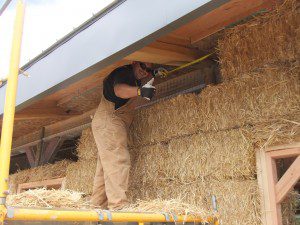
The entire day is an exercise in what I call Rolling With It. Using reclaimed or found products sometimes means that you need to make adjustments that weren’t according to plan; using volunteer labor (of variable proficiency) definitely calls for the same kind of adaptability! Unforeseen challenges are faced down and conquered, and we troop off to dinner feeling like we accomplished something. Campfire tonight, with a little drinking and a lot of jokes.
Straw is classified as a “rapidly renewable resource” – that is, it has a short growing cycle and does not require much energy to grow or harvest or process into a building material. More conventional products such as concrete and steel require a great deal of energy to mine and process, while timber harvesting can be devastating to biohabitats unless managed carefully. When locally grown straw is used, the fuel costs and environmental degradation associated with shipping exotic materials over long distances are eliminated.
But green building design delves past practical considerations of resource management, and into quality-of-life concerns. Cradle to Cradle is an influential book by William McDonough and Michael Braungart that challenges the common perception that sustainability equals yurts and dirty feet. Sustainable design is not a sacrifice – it need not be crunchy, poor and second best – but can, and should, be productive and lively and more fulfilling than the status quo. “Regenerative design” is another term representing the belief that thoughtfully designed environments and products can actually generate more resources than they consume: more electricity, more food products, more usable water, more happiness …
Day 3
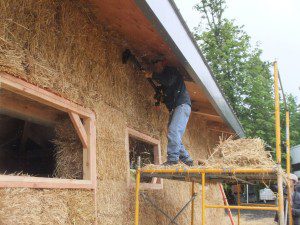
The “toe-up”, or perimeter foundation upon which the bales will sit, is composed of preservative-treated wood members on either edge and some drainage medium in between – usually gravel – that will allow any water in the wall to drain to the exterior. We drive large nails at intervals into both wood members all the way around the building, and then suddenly Sarah and Ken are summoned and given the honor of setting the first bale. They pick one up and jam it down onto our foundation nails – it’s that easy, pretty much. So off we go around the perimeter, stacking bales like giant bricks until the building is mostly enclosed.
This evening we linger around a portable propane heater, and as the night grows old the conversation turns deep and personal and emotional. Many of us are struggling with work issues, life issues; we are somehow drawn to alternative building and ecological conservation because these seem to offer a renewal of simple, honest living. In fact we are already feeling the effects of working together for a common cause, absent financial or social gain, and this does indeed feel like renewal.
Tom Nelson is an architect with substantial experience in straw bale permitting and construction. When I asked him about obstacles to “mainstreaming” the technique, he laughed. “That’s an easy question, because I’m asked the same three questions over and over and over: ‘It’s a fire hazard, right?’ ‘Doesn’t it get eaten by pests?’ ‘Doesn’t it rot?’”
In fact, the material used for bales performs very well against these three threats. It’s not hay at all: the straw used in bales is a waste product from the farming of grains such as wheat, rye, rice, or hemp. In California, where we live, rice straw is an excellent choice for straw bale builders. For decades rice straw waste was eliminated by burning, and this practice was one of the major contributors to air pollution in California’s Central Valley – so its reuse as a building material solves more problems than the obvious one of thermal insulation.
Day 4
The straw work gets more technical today and there is a great deal of Rolling With It. At the top of the walls we have to cram bales in under the overhanging rafters, cutting and testing and re-doing all day long. It’s physical work up there on the scaffold, and it’s also strategic work. Andrew offers an endless supply of useful construction advice to help us persuade the building materials into behaving. We do some things incorrectly and then we do them correctly, and in this way we gain confidence that we can each build our own straw bale building someday.
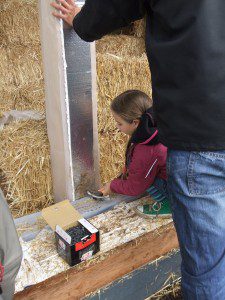
The chemical makeup of rice straw contains a very high percentage of silica, the mineral that also makes up sand. As such it makes for a poor food source for pests such as rats and termites – much less delectable than the wood studs that form the skeleton of my 1940s cottage. Rice straw is hydrophobic: it naturally repels water, like the feathers of waterfowl or many other natural substances whose existence is spent submerged in water. Like all natural materials, straw prefers to “breathe”, or dry out naturally, so the moisture content at the compressed center of each bale must not exceed a certain percentage or else it will indeed rot – but so will wood studs, as many homeowners have discovered the hard way.
The question of fire is an interesting one. The process of compressing straw into bales means that there is little oxygen on the interior of the bale, and oxygen is necessary for combustion. When bales are set alight, the exterior will burn and char, but that same char is then no longer a fuel source, and the fire will burn itself out. A similar effect is observed with the huge pieces of wood used in “heavy timber” construction, or even at your beachside bonfire: if the material’s too thick, you won’t be roasting marshmallows over it for long.
Day 5
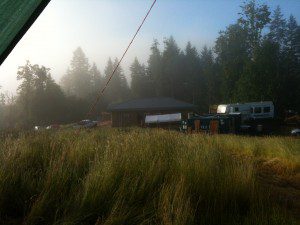
Sarah has pizza brought in for us tonight, and we move the picnic benches indoors to enjoy dinner in the newly closed-in building. Protected from the wind and warmed by wine, we are decidedly merry tonight, with much Facebook-friending and picture-sharing. We do some networking too, but it doesn’t feel icky: it feels like people who genuinely enjoy working together are making promises to share work in the future. I realize that Andrew has subtly brought this about just by setting an example.
It is a construction project after all, and that setting can tend to bring out the coarse and critical in people; even in sedentary work there is a tendency in many of us to become judgmental towards colleagues with lesser skill or drive. But Andrew is unfailingly respectful and cheerful towards everyone, and we subconsciously emulate him, and good will prevails.
Natural hydraulic lime plaster is the finish of choice for straw bale buildings, both on the exterior and the interior wall surface. Any of the other common cladding materials are possible, such as wood siding or shingles or flagstone. But the bales will perform best if such finish choices are installed as a rainscreen, meaning they are held off the wall with a small gap and installed over at least one coat of plaster for fireproofing and protection.
The lime plaster is applied in a similar manner to the more common industrial material called cement plaster, or stucco: the first layer, or “scratch coat”, is applied over a lath or other rough surface and allowed to cure; a second “brown coat” is applied which evens out irregularities; the thin “finish coat” is the one we see. What sets lime plaster apart is its ability to allow the bales to “breathe”, and its much gentler impact on the environment. Instead of releasing carbon dioxide permanently into the atmosphere during processing, lime plaster will naturally “sequester” carbon dioxide back into its structure as it cures, so the end result is chemically close to the limestone from which it was mined.
Day 6
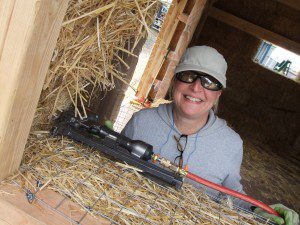
The nefarious miller’s knot must be conquered today, but we conquer it quickly – because every bit of wall must be “sewed” together. The baling needle is a steel rod as long as my arm, with a T-shaped handle at the top, notched like a crochet hook at the tip. I hook twine through the notch and force the needle through the bale so that it leaves the twine end on the other side, where my friends are waiting to tie the ends together tightly through the steel mesh. Soon each wall is crisscrossed like a giant needlepoint, and from its rough and shaggy beginnings the wall has become implausibly firm and straight.
I am thinking a lot about leadership today, and about my role in the world as a professional and a female. There is a young woman from Washington here who is especially capable with the construction equipment, and we have come to share a running joke about being “outsourced”: whenever we have laid claim to a portion of work, we somehow end up losing hold of it as one of the more experienced men takes over. We’re laughing about this phenomenon, but as with any joke there is a kernel of pain at the center. I don’t believe there is any malice intended by these guys. In fact, I start to recognize a pattern in myself (and in many women) of relinquishing, of stepping back out of a leadership position into the comfortable role of helpmate. It’s an old and ingrained habit, very hard to alter. My effectiveness as a project manager suffers. I consider how different this workshop would be if Andrew’s attitude were deferential and self-effacing, and it almost makes me laugh out loud. People crave strong leadership. I’ve been reluctant to exhibit it for decades – what a waste.
The most obvious benefit of using stacked straw as a building wall is that it provides very good insulation against both temperature differential and against noise. For those (like my family!) accustomed to living in a cheaply constructed postwar house, the level of comfort afforded by a well-designed straw bale interior is startling. All the senses are invoked. Calm quiet reigns, daylight streams through the deep window openings and highlights the texture of the plaster, and the interior temperature remains close to 70 degrees year round regardless of the climate – usually with little or no mechanical heating or cooling. This means more to me than an economic savings on energy costs: this means a step closer to independence and self-reliance.
By tradition, each straw bale building incorporates a “truth window” – a small opening covered by a door or window that, when opened, reveals the surprising truth about the wall’s interior. The effect is magical, like stumbling upon the wardrobe to Narnia.
Day 7
Sunday dawns downright hot, which causes some amusement since the wet cool weather of the earlier part of the week would have been perfect for plastering. But the workshop is over at 4pm sharp, and we’re committed to getting the building weatherproofed. The work day begins early. Ken has rented a mixer and Andrew demonstrates the ratios and techniques necessary for mixing a good batch of plaster: sand, natural hydraulic lime, and water. It’s a lot like cooking, in that you need more than a simple recipe in order to make it taste good – a bit more water can either fix your soup or ruin it.
All thirty of us, armed with hawks and trowels, line up around the perimeter and begin pushing the mud up the walls. Muscles long unused are quickly crying for mercy, because the plaster must be pushed hard into the damp surface of the straw and spread evenly. It’s hard, then it’s easier, and then we realize our bodies have figured it out.
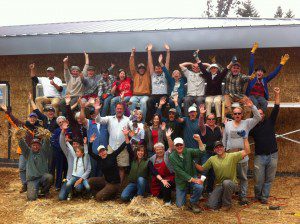
The plane ride home affords me a bit of time to process, and I find myself thinking of something Andrew said at one point: “I have no idea what 90 percent of you do for a living, and frankly it doesn’t matter”. When this was uttered I was a tiny bit miffed. A great deal of my life has been sunk into this profession, and I had thought it was a large part of my identity.
The teachers and attorneys and programmers I met this week may have felt the same way. But do our professions really define us, or do our passions define us? Sometimes the two are not precisely aligned. I think now that that schism was largely what drove us together at this rather arcane workshop in the Oregon countryside: whether seasoned employees or still in school, we have each made an effort to align our daily lives with our true passions. It is empowering to realize that a little bit of communal work can carry us so far along that road, and now I’m at the crossroads. If I am not completely passionate about the way I spend my days, I have a choice: to settle under inertia’s heavy weight, or to be brave and start forth again on my journey.



3 Responses
Hi is it possible to do a strawbale house on stilts? Thanks
Hi Cheryl. Yes, it is possible. You will need to make sure that the stilts and floor system are engineered to handle the extra weight of the bales.